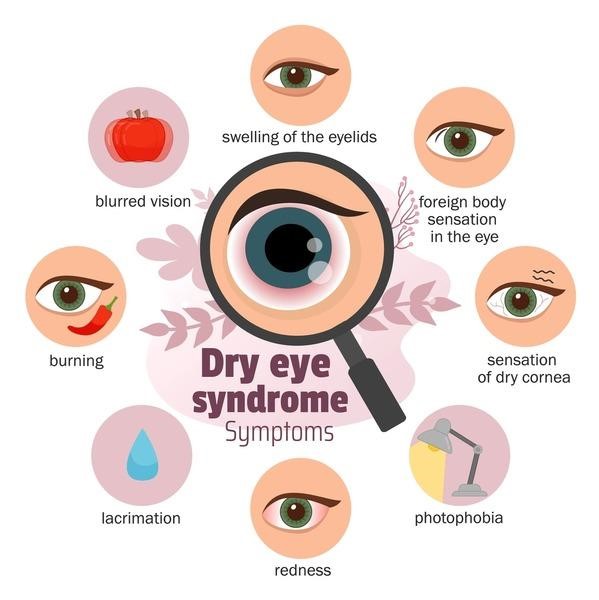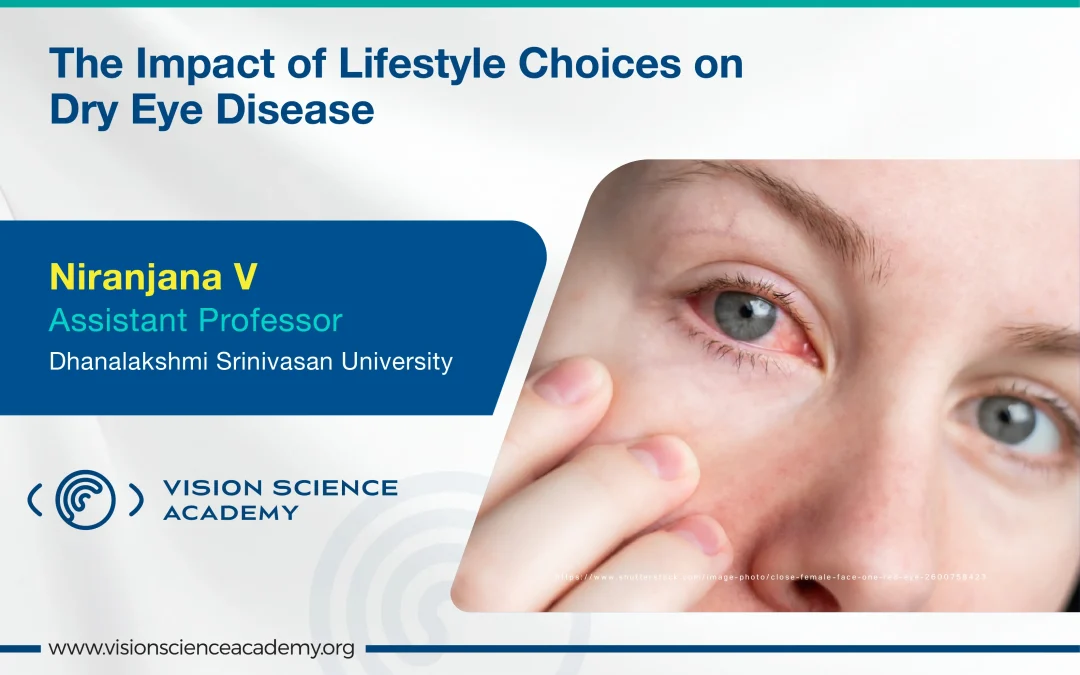Niranjana V, M. Optom., FBDO
Assistant Professor, Dhanalakshmi Srinivasan University, Trichy, India
Dry Eye Disease (DED) is a growing concern affecting millions globally, characterised by inadequate tear volume. This condition, characterised by discomfort, dryness, and visual disturbances, is influenced by modern lifestyle habits. Several management methods are emerging to treat dry eye, such as artificial tear supplementation and punctal occlusion to preserve tears. Several studies highlight how diet, screen time, physical activity, and other behaviours play a critical role in the onset and management of DED. (1)
Understanding Dry Eye Disease
DED occurs when there is an imbalance in tear production or evaporation, leading to ocular discomfort and potential damage. Risk factors range from age and gender to environmental exposure and daily habits, making it a complex condition with varied triggers. (2)

Figure 1: Symptoms of Dry Eye Syndrome
Lifestyle Factors Contributing to DED
- Dietary Choices: Vitamin D and omega-3 fatty acids have emerged as key nutrients in maintaining ocular health. Anti-inflammatory properties of Vitamin D support tear stability, while omega-3 supplementation has been shown to reduce symptoms and enhance tear quality. However, inconsistent evidence underscores the need for further research. (1)
- Screen Time: Prolonged use of screens significantly contributes to DED. (1,3) Reduced blink rates during screen use increase tear evaporation, exacerbating symptoms. Simple strategies, such as the 20-20-20 rule, can help alleviate these effects. (1)
- Smoking and Alcohol: Smoking damages meibomian glands, leading to reduced tear stability and higher risks of DED. Quitting smoking not only benefits overall health but also improves ocular well-being. (1) Meanwhile, alcohol consumption has mixed associations with DED, with some studies showing adverse effects on tear quality. (2)
- Physical Activity: Aerobic exercise has a protective effect on eye health. Regular physical activity enhances tear secretion, reduces inflammation, and promotes tear film stability, highlighting its role in managing DED symptoms. (1,2)
Emerging Insights on Behavioural Factors
Recent studies delve deeper into modifiable risk factors. Higher caffeine intake has been associated with a lower prevalence of DED, suggesting its protective potential. (3) Conversely, prolonged commuting, whether driving or train travel, has been linked to increased symptom severity, possibly due to environmental exposure. (3)
Spending time outdoors also appears beneficial, particularly for contact lens users, as it promotes natural blinking and reduces near-work activities, both of which help alleviate DED symptoms. (3)
Targeting Modifiable Risk Factors
- Adjust Your Diet: Incorporate omega-3-rich foods and consider supplements to enhance tear stability. (1)
- Manage Screen Habits: Limit screen time and adopt protective strategies like proper lighting and ergonomic setups. (1)
- Stay Active: Engage in regular aerobic exercise to support systemic and ocular health. (1,2)
- Quit Smoking: Eliminate smoking to improve tear production and reduce ocular irritation. (1)
- Practice Eye Hygiene: Follow good practices for eye care, including adequate hydration and regular breaks during near-work activities. (2,3)
Conclusion
Dry Eye Disease reflects modern lifestyle choices, and its management lies largely within our control. Simple changes, such as improving diet, reducing screen time, and staying active, can significantly alleviate symptoms and improve quality of life. By fostering awareness and prioritising prevention, individuals can take proactive steps toward maintaining long-term ocular health. (1,3)
References
- Dyrek, Martyna & Partyka, Aleksandra & Małachowski, Aleksander & Malinowski, Piotr & Błaszczak, Ewa & Kopczyńska, Urszula & Kopczyński, Cezary & Wójcik, Jakub & Gurdak, Kinga & Dydyk, Martyna. (2024). Dry eye disease – how our lifestyle choices can affect the disease?. Journal of Education, Health and Sport. 70. 55791. 10.12775/JEHS.2024.70.55791.
- Graham, Andrew & Wang, Jiayun & Kothapalli, Tejasvi & Ding, Jennifer & Tasho, Helen & Molina, Alisa & Tse, Vivien & Chang, Sarah & Yu, Stella & Lin, Meng. (2024). Artificial Intelligence Models Utilize Lifestyle Factors to Predict Dry Eye-Related Outcomes. 10.21203/rs.3.rs-4536316/v1.
- Wang, Michael & Muntz, Alex & Mamidi, Brinda & Wolffsohn, James & Craig, Jennifer. (2021). Modifiable lifestyle risk factors for dry eye disease. Contact Lens and Anterior Eye. 44. 10.1016/j.clae.2021.01.004.


Recent Comments